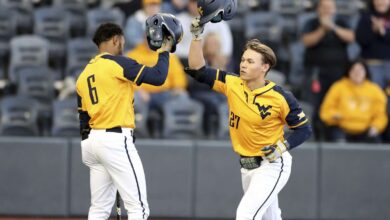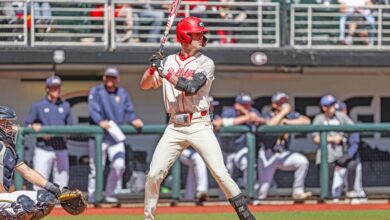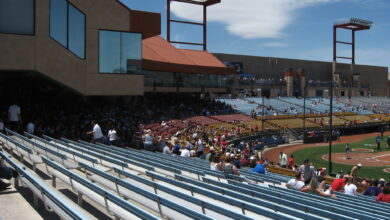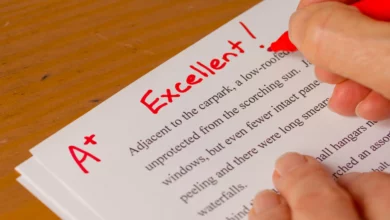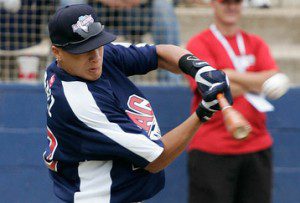

The 2011 major league amateur draft was extremely deep, especially with pitchers. The class has the potential to go down as one of the best ever with several future top-of-the-rotation starters, as well as some outstanding impact offensive players. Let’s take a look at the top 10 picks and how they have fared so far, as well as their future potential.
1. Gerrit Cole, Pirates, RHP, 6’-4”, 220 lbs, 21 (age)
The Pirates made Cole, who was also a first-round pick by the Yankees in 2008 out of high school, the number-one overall selection in the draft. The big, power righty is a workhorse who has drawn comparisons to Roger Clemens for his rocket arm and strong presence on the mound. Went 6-8 for UCLA his junior season, posting a 3.31 ERA and 1.10 WHIP. He had 119 strikeouts to only 24 walks over 114.1 innings, showing great command of his pitches. Finished his career with 376 strikeouts over 322.1 innings, ranking second on UCLA’s all time list.
Cole made his pro debut at the Arizona Fall League and was one of the most impressive pitchers at the hitter-friendly league. He went 2-0, with a 3.00 ERA, 0.93 WHIP and held opponents to a .183 average over 15 innings. He struck out 16, while walking only four batters. He features three plus-pitches in his arsenal, including a four-seam fastball that can hit triple digits with movement and a two-seam fastball that sits in the mid 90s. As good as those pitches are, his best is his change-up. Hitters gearing up for a 98 mph fastball, then having to adjust to an 86 mph off-speed pitch, which looks the same from the delivery, is simply unfair. His slider is also an above-average offering and getting better. Cole is a future ace and should team up with 2010 first-round pick, Jameson Taillon, to give the Pirates a devastating 1-2 punch they haven’t had in, well, forever. He should start the season at class-A Bradenton, but also could begin at double-A Altoona to get him on the fast track.
2. Danny Hultzen, Mariners, LHP, 6’-2”, 200 lbs, 22
The Mariners took the best left-hander available in the draft in Hultzen, a three year starter at Virginia. In 33 starts over his three seasons, he went 32-5 with a 2.18 ERA and 1.01 WHIP, while holding opponents to a .209 average. He also had 378 strikeouts to only 69 walks over 305.1 innings, ranking first in school history.
Like Cole, Hultzen made his pro debut at the Arizona Fall League and dominated opposing hitters. He went 1-0 with a 1.40 ERA, 1.09 WHIP and had 18 strikeouts to just five walks over 19.1 innings. Hultzen is a superb command pitcher who is also ultra-aggressive on the mound, not afraid to go in and out at will, and will throw any pitch in any count. He mixes a plus-mid-90s fastball with late sink and a deceptive change-up that sits in the 82-85 mph range to keep hitters off balance. The change-up also rates as plus while his slider is above average and still developing. He has advanced command of all three pitches, but what sets him apart from the rest is his poise and instincts on the mound. Hultzen will most likely either start the season at class-A High Desert, or double-A Jackson. He is another future ace who could team up with Felix Hernandez, as well as super prospects Taijuan Walker and James Paxton, to give the M’s one of the best rotations in baseball very soon.
3. Trevor Bauer, Diamondbacks, RHP, 6’-1”, 175 lbs, 21
The Diamondbacks had two picks in the top seven, a first in the draft’s history. They used their first one on a UCLA pitcher with an unorthodox delivery who happened to put together one of the most dominant pitching seasons ever. Bauer went 13-2 with a 1.25 ERA and 0.80 WHIP, and had 203 strikeouts to only 36 walks over 136.2 innings. He also held opponents to a .155 batting average. He would leave UCLA as the all-time leader in wins (34), strikeouts (460) and innings pitched (373.1), while teaming up with Cole to form one of the most dominant 1-2 combos in recent memory.
Bauer made his debut at class-A Visalia, and over three starts, he went 0-1 with a 3.00 ERA and 17 K/4 BB over nine innings. He then made the jump to double-A Mobile where he made four starts, going 1-1 with a 7.56 ERA and 26 K/8 BB over 16.2 innings. His season totals of 1-2, 5.96 ERA and 1.52 WHIP may not look that impressive, but if you take out his last start, in which he gave up 10 earned runs on eight hits over 1.2 innings, his totals would be 1-1, 2.62 ERA, 1.16 WHIP and 40 K/9 BB over 24 innings. His 15 K/9 reflect the type of dominant pitcher he is.
Bauer has a ridiculous arsenal of pitches at his side. His fastball has many variations, with his four-seam touching the upper 90s. He also has a plus 12-6 hammer curve, as well as a plus slider with late fade. His change-up is above average, and he will throw all of his pitches at any time in any at-bat. He will most likely start the season at Mobile, with a real chance to make the majors by season’s end.
4. Dylan Bundy, Orioles, RHP, 6’-1”, 200 lbs, 19
Before his senior season at Oswasso HS in Oklahoma, Bundy sat down with his dad and made some goals for the season. He said he wanted to hit 100 mph with his fastball, have a zero ERA and not walk a single batter all year. Well, he almost achieved all of his goals. He went 11-0, with a 0.20 ERA and 158 strikeouts over 71 innings. Oh, and he walked five batters. He didn’t reach 100 mph either, but he has since, with reports saying he has hit triple digits on several occasions over the winter. He was named the high school Gatorade Player of the Year and the Orioles selected him with the fourth-overall pick in the draft.
Bundy hasn’t started his pro career yet, but the Orioles have added him to their 40-man spring training roster to get him some workouts with the big boys. At age 19, they aren’t going to rush the future of their franchise, so he will most likely begin the year at class-A Delmarva or Frederick. His four-seam, as mentioned, can reach the upper 90s with ease. His cutter is a great balance to the fastball, sitting in the low 90s while sitting on the same plane, baffling hitters all the way to the dugout. His curve is a potential plus pitch that sits in the upper 70s, but he is primarily using his fastball and cutter right now. Bundy is as intense a player as you will ever meet. With a crazy workout regimen and focus to get better everyday, failure isn’t an option with him. He treats every at-bat like a battle, like it’s the bottom of the ninth, holding a one-run lead in game seven of the World Series.
5. Bubba Starling, Royals, OF, 6’-5”, 200 lbs, 20
The Royals selected Mr. All American with the fifth-overall pick. Starling was an all-state performer in baseball, football and basketball playing for Gardner-Edgarton HS in Kansas. Aside from being rated as the top baseball player in the nation, he was also one of the top quarterbacks and had a scholarship to play the position at Nebraska. He can hit 500-foot home runs, throw a baseball ball 95 mph, toss a football 80 yards (55 from two knees), run a 4.3/40, dunk a basketball and, most likely, he dated the prettiest girl in all of Kansas. He rushed for over 2,400 yards as a senior, averaging 14 per carry, averaged 28.3 points per game in basketball and hit .481 in baseball, homering once every six at-bats.
Jealous yet?
Starling passed on a potential NFL career to pursue baseball, a la Joe Mauer. He has true 30 HR/30 SB potential, and his ceiling is limitless with all of the intangibles he has. He was regarded as the best high school athlete since Dave Winfield was drafted in three different sports in 1973. He has yet to start his pro career but should start the season at either class-A Kane County or Wilmington. He is definitely one to keep an eye on this season.
6. Anthony Rendon, Nationals, 3B, 6’-0”, 190 lbs, 21
The Nationals were coming off back-to-back number-one overall picks heading into this draft. They chose two franchise cornerstones in Stephen Strasburg in 2009, and Bryce Harper in 2010. Strasburg was the top collegiate pitcher, and Harper was one of the most hyped prospects of all time. They went with the top collegiate bat last season in Rendon, a kid who had a disappointing junior season, mostly because of a shoulder injury.
He was named National Freshman of the Year at Rice in 2009 after hitting .388 with 20 home runs, 72 RBI and a 1.170 OPS. He drew 31 walks while only striking out 23 times. He improved on those numbers as a sophomore, winning National Player of the Year honors by hitting .394 with 26 home runs, 85 RBI and a 1.340 OPS. He showed his great approach at the plate by taking 65 walks to only 22 strikeouts. Even with the dip in power numbers his junior year, six home runs, 37 RBI and a .327 average, he still had a 1.043 OPS and drew 80 walks to just 33 strikeouts. He had two ankle surgeries over his career, and with the shoulder injury, his draft status appeared up in the air at times. Still, Nationals GM Mike Rizzo was thrilled to get him at pick seven. When healthy, he is the total offensive package with the ability to be a perennial batting champion contender, as well as a 30+ home run hitter. He is also a plus defender in the mold of an Evan Longoria.
All medical reports have come back clean, and Rendon appears to be 100 percent healthy going into his first pro season. He will most likely start the season at class-A Hagerstown or possibly even double-A Harrisburg. Either way, he will be on the fast track to the majors to join Strasburg and Harper as three cornerstones for the future.
7. Archie Bradley, Diamondbacks, RHP, 6’-4”, 220 lbs, 19
The Diamondbacks got the seventh pick for failing to sign their 2010 first-round pick, Barret Loux, who failed a physical, then signed with the Texas Rangers as a free agent. The Diamondbacks, after taking a potential future ace in Bauer, decided to go after another one in Bradley, a big, power righty from the same neck of the woods as Bundy.
Playing for Broken Arrow HS in Oklahoma, just a stone’s throw from Oswasso HS where Bundy played, Bradley was just as dominant as his counterpart. He went 12-1, with a 0.29 ERA and 137 K/11 BB over 71.1 innings his senior season. He led his team to a state title by tossing seven scoreless innings, allowing just two hits, while striking out 14 in the title game. He also was a star quarterback, much like Starling, and had a commitment to play at Oklahoma.
Bradley signed for $5MM and headed straight to the Diamondbacks’ Rookie League, where he pitched two shutout innings, striking out four while allowing one hit. At the team’s Instructional League over the fall, he was brilliant. Over 15 innings, he posted a 2.40 ERA, allowed just five hits and had 22 strikeouts to only four walks.
Bradley features three outstanding pitches, with his curveball being his best. It is a knuckle-curve that sits in the mid 80s and is a true 12-6 wipeout pitch. His four-seam fastball can reach 98 mph, while his two-seamer sits in the mid 90s with late fade. His change-up is still developing but looks to be a solid offering. Bradley will most likely start the season at either class-A South Bend or Visalia, and even at just 19 years of age, could be on the fast track to the majors due to his durability and advanced feel for the game.
8. Francisco Lindor, Indians, SS, 5’-11”, 175 lbs, 18
The Indians selected the youngest player in the draft, a 17-year-old out of Montverde Academy in Florida, who also happened to be the best shortstop in the draft. Lindor is an exceptional defender with a canon arm, soft hands, great footwork and a very high understanding of the game. He has a feel and instincts for the game not seen in many players his age.
As a senior, he hit .528 with six home runs, 13 RBI and 20 stolen bases. He is the prototypical leadoff hitter with his speed and ability to hit for a high average from both sides of the plate. At 5’-11”, 180 lbs, he still has room to grow and could develop more power down the road. He definitely has the ability as he won the home run derby at the 2010 AFLAC All-American game at PETCO Park.
Lindor made his pro debut at short-season Mahoning of the New York Penn League. Over five games, he went 6-19 (.319) with four runs, two RBI and a stolen base, while showing off his defensive skills. He then played in 12 games at the team’s Instructional League where he went 7-28 (.250) with three doubles, one triple and three RBI. He also showed a good approach at the plate by taking five walks to only seven strikeouts. The Indians already have an All-Star shortstop in Asdrubal Cabrera. As good as he is, Lindor projects to be better, especially on defense. At just 18 years of age, the Indians have a couple of years before they have to cross that bridge, however. For now, Lindor will most likely head to class-A Lake County to begin his first full professional season in 2012.
9. Javier Baez, Cubs, SS, 6’-0”, 180 lbs, 19
The Cubs have had one of the worst farm systems in baseball in recent years. Holding the ninth-overall pick in the draft, they had to get this one right. Even with Starlin Castro looking like a franchise player at shortstop, the Cubs decided on another shortstop in Baez, the top-rated high school hitter out of Arlington Country Day HS in Florida. Some scoffed, but you don’t draft on need when it comes to the MLB draft, you take the best available player, and that was Baez. At 6‘-1“, 210 lbs, he has the size, arm and range to play third base. And what I am about to show you will blow your mind. Here are his senior season stats:
64-83 (.771 AVG), 20 2B, 6 3B, 22 HR, 52 RBI, 28 SB, 32 BB, 3 K, .835 OBP/1.952 SLG/ 2.787 OPS
Now, I know high school stats can get ridiculous at times, but I couldn’t put up those numbers hitting in my backyard, by myself. Baez has extremely quick wrists which allow him to turn on any pitch, while also showing great plate discipline. He shows the ability to be a high-average hitter with power to all fields, and offensively, draws comparisons to former Cubs’ third baseman, Aramis Ramirez. One knock on him has been his attitude, but scouts say his fiery personality on the field is one of his best assets. He began his pro career at the team’s Rookie League, going 4-12 (.333) over three games, hitting two doubles while stealing two bases. He then played in two games at short-season Boise, going 1-6 (.167) with an RBI. The Cubs then shipped him to their Instructional League, where he went 6-22 (.273) over six games with two doubles, an RBI and a stolen base. He should start the season at either Class-A Boise or Daytona and instantly becomes one of the Cubs’ top prospects.
10. Cory Spangenberg, Padres, 2B, 6’-0”, 185 lbs, 21
The Padres used their pick on the purest hitter in the draft not named Rendon. Spangenberg, a lefty with the quickest bat in the draft, is a hitter in every sense of the word. With his short, compact swing, he drives the ball to all fields, and always seems to find the gaps. He also has elite speed, having been reportedly clocked at 3.47 seconds to first base, which is Olympic-type stuff. After hitting .480 his senior season at Abington HS in Pennsylvania, he enrolled at the Virginia Military Institute where he hit .370 with 11 home runs, 49 RBI and 24 stolen bases. He then went to the Valley League and won MVP honors by leading the league with a .399 average. The league uses wooden bats and his success opened eyes to every scout, for every team. He then put a stamp on his draft status by hitting .477 with five home runs, 32 RBI and 33 stolen bases at Indian River State Community College.
Spangenberg made it a point to sign quickly so he could begin his first professional season earlier than most of his draft mates. He reported to class-A Fort Wayne and abused pitchers by hitting .384 over 25 games. He scored 20 runs, smacked 10 doubles, one home run, 20 RBI and stole 10 bases. He also showed incredible plate discipline by taking 31 walks to only 15 strikeouts. His success lead to his promotion to high class-A Lake Elsinore, where he found the competition a little tougher. He still hit .286 over 47 games with seven doubles, two home runs, 24 RBI and 15 stolen bases., but his 14 walks to 42 strikeouts showed he was outmatched at times.
Still, with more games under his belt than any of the other draftees, he is a step ahead of everyone as far as development goes. He will most likely begin the season at Lake Elsinore again, and I wouldn’t be surprised if he ended the season at triple-A Tucson. He is that good.


